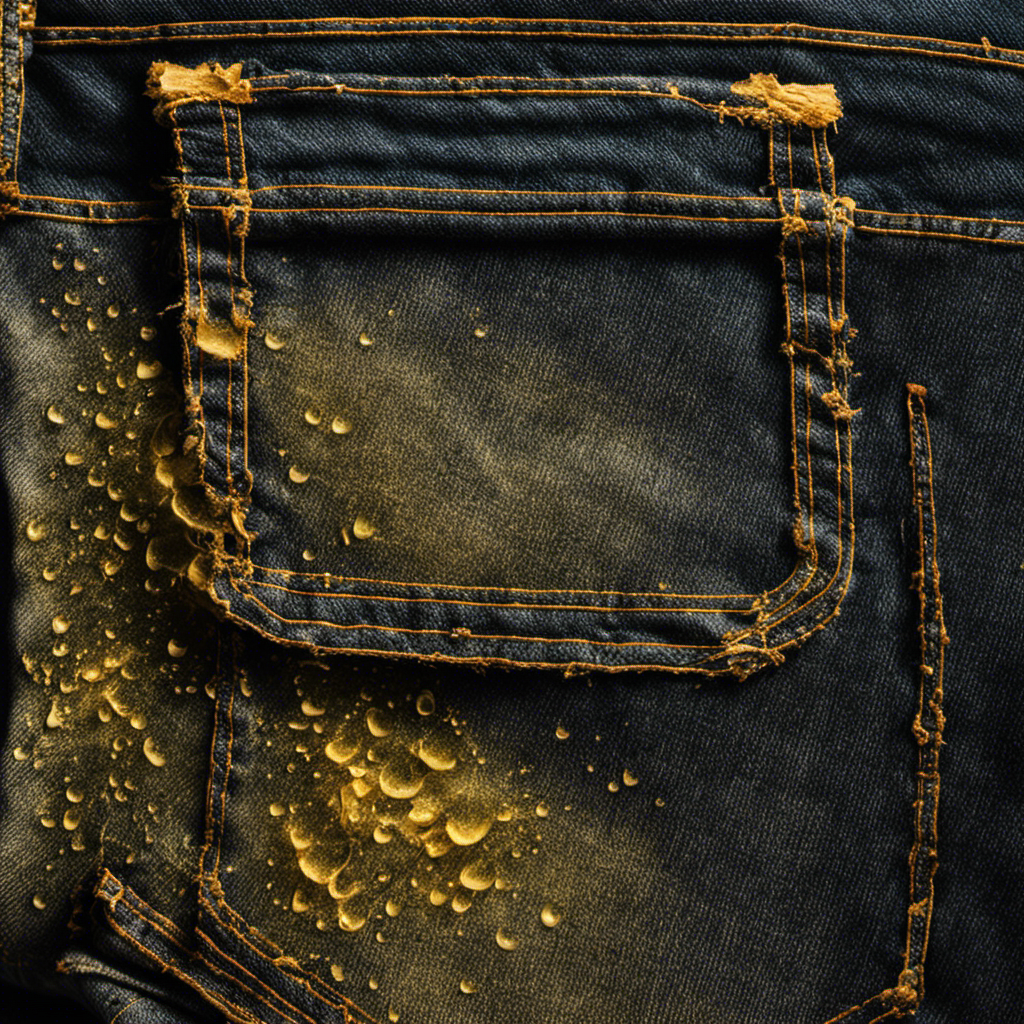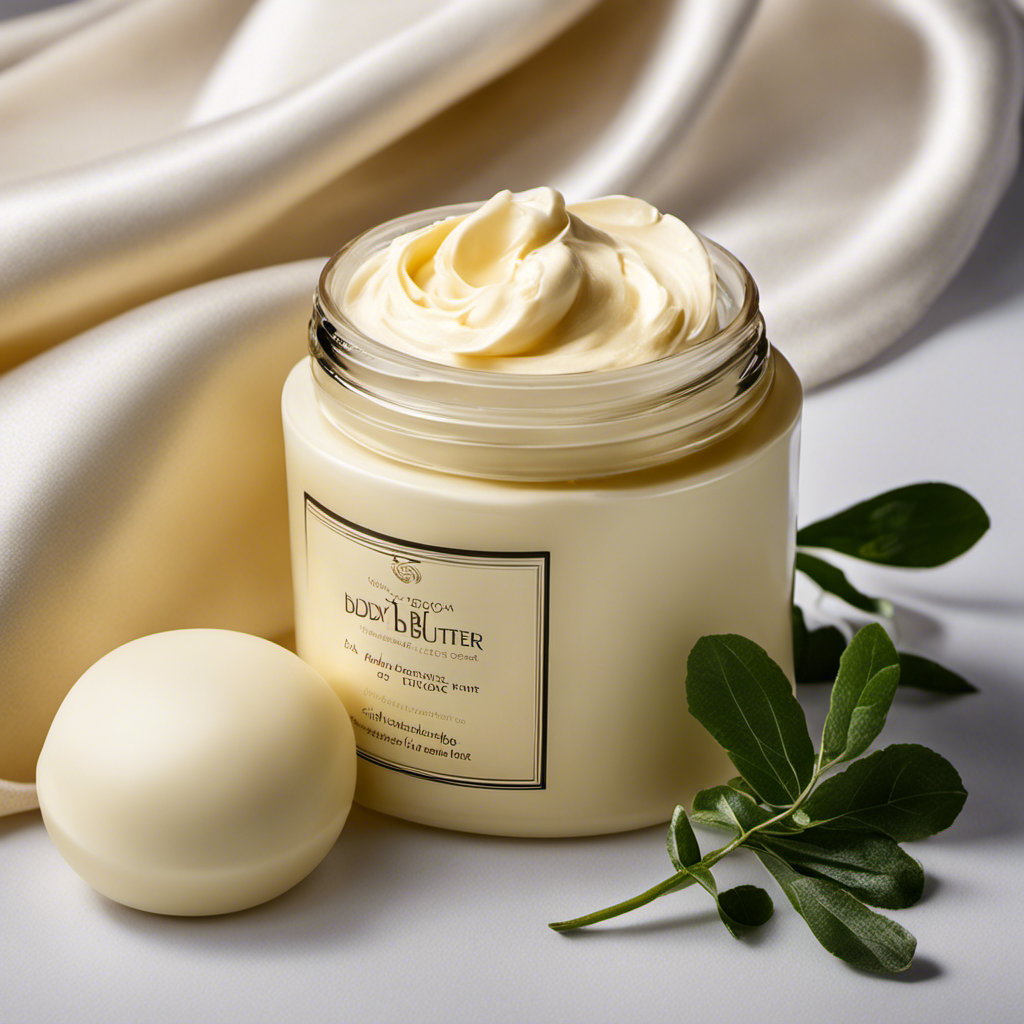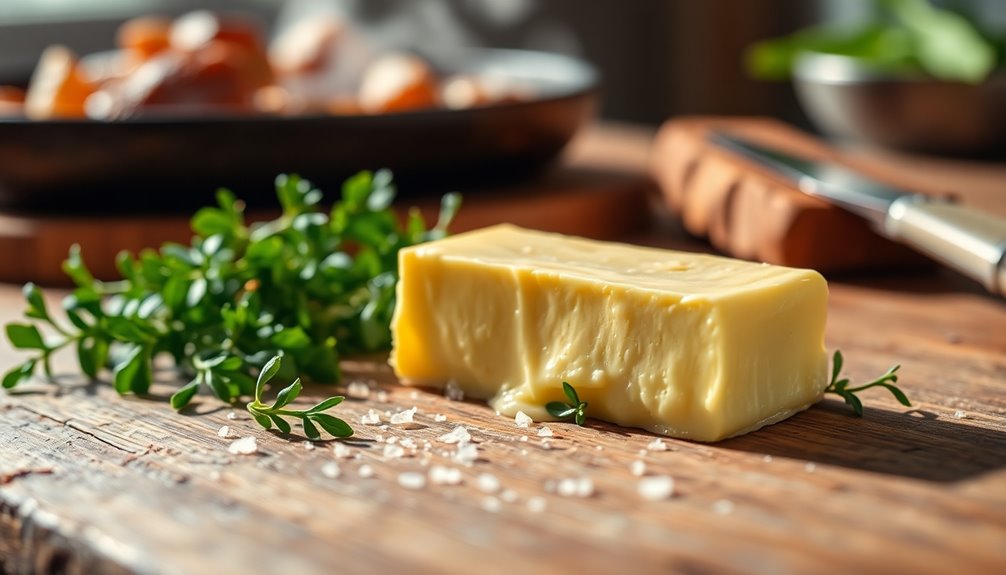I’ve experienced that situation before – the feeling of disappointment when a butter stain suddenly shows up on my favorite shirt. It can be quite annoying, right?
But fear not, because I’ve got just the solution for you. In this article, I’ll share my tried and true method for getting butter out of clothing. From pre-treating the stain to choosing the perfect stain remover, I’ll guide you through every step of the process.
So get ready to say goodbye to those pesky butter stains once and for all!
Key Takeaways
- Hot water can set the butter stain, so it’s important to avoid using it.
- Gently scrape off excess butter before treating the stain.
- Pre-treat the stain with a stain remover or liquid detergent before laundering.
- Use effective solvents such as dish soap, rubbing alcohol, baking soda paste, or white vinegar to remove oily residue.
Understanding the Butter Stain
To understand how to get butter out of clothing, it’s important to know how the butter stain behaves on different fabrics. Understanding the science behind it can help us tackle the problem effectively.
Firstly, butter is an oil-based stain, which means it can be quite stubborn to remove. Many people mistakenly believe that hot water or soap alone will do the trick, but this is not always the case. In fact, using hot water can actually make the stain worse by setting it into the fabric.
Instead, it’s best to start by gently scraping off any excess butter with a dull knife or spoon. Then, apply a pre-treatment stain remover or liquid detergent directly to the stain and let it sit for a few minutes before laundering as usual.
Pre-Treating the Stain
When it comes to pre-treating stains, there are three key points to consider.
First, removing oily residue is essential. Oily residue can be stubborn, but using a degreaser or dish soap can help break it down before treating the stain.
Second, choosing effective solvents is crucial. When choosing a solvent, it’s important to consider the fabric and the specific stain. Different solvents work better on certain materials and substances.
Finally, proper stain application is necessary. This involves gently dabbing the solvent onto the stain, avoiding rubbing which can spread the stain or damage the fabric.
These three points should be kept in mind when pre-treating stains.
Removing Oily Residue
You can use dish soap and warm water to remove the oily residue from your clothing. This method is effective and convenient, as it utilizes common household items instead of relying on professional dry cleaning.
To begin, dampen the stained area with warm water. Then, apply a small amount of dish soap directly onto the stain. Gently massage the soap into the fabric, working it in a circular motion. Allow the soap to penetrate the stain for about 10 minutes.
Next, rinse the area with warm water until the soap is completely removed. Pat dry with a clean towel and check for any remaining residue. If necessary, repeat the process until the oily residue is completely gone.
Choosing Effective Solvents
Using common household solvents, such as dish soap or rubbing alcohol, can effectively remove oily residue from clothing. Here are some effective cleaning solutions to consider:
-
Dish Soap: Mix a small amount of dish soap with water to create a soapy solution. Apply it directly to the oily stain and gently rub it in. Rinse with cold water and repeat if necessary.
-
Rubbing Alcohol: Dab a cloth or cotton ball soaked in rubbing alcohol onto the oily residue. Blot the stain until it lifts, then rinse with cold water.
-
Baking Soda: Create a paste by mixing baking soda with water. Apply the paste to the stain and let it sit for 30 minutes. Rinse with cold water and wash as usual.
-
White Vinegar: Mix equal parts of white vinegar and water. Use a sponge or cloth to blot the stain with the solution. Rinse with cold water and repeat if needed.
When it comes to removing oily residue, it’s important to avoid common stain removal mistakes. For example, avoid using hot water, as it can set the stain. Additionally, refrain from rubbing the stain vigorously, as it can push the oil deeper into the fabric. Instead, gently blot or dab the stain to lift the residue.
Proper Stain Application
To properly apply a stain remover, make sure to follow the instructions on the product label.
When it comes to butter stain prevention, it’s important to act quickly. Once you notice the stain, scrape off any excess butter using a butter knife or spoon. Avoid rubbing the stain, as this can push it deeper into the fabric. Instead, blot the stain gently with a clean cloth or paper towel to absorb as much of the butter as possible.
Once you’ve removed the excess, you can try alternative stain removal methods. For example, you can apply a small amount of dish soap directly to the stain and gently rub it in. Let it sit for a few minutes before rinsing with warm water. Repeat this process until the stain is gone.
Another option is to make a paste using equal parts baking soda and water, apply it to the stain, and let it sit for about 30 minutes before rinsing.
These methods can be effective in removing butter stains from clothing.
Choosing the Right Stain Remover
When it comes to removing butter stains from clothing, it’s important to choose the right stain remover. Evaluating the effectiveness of different options can save you time and frustration.
Here are some practical steps for testing alternatives:
-
Read product labels: Look for stain removers specifically designed for grease or oil stains. These products often contain enzymes or solvents that break down the butter residue.
-
Conduct a spot test: Before applying any stain remover to your clothing, test it on a small, inconspicuous area to make sure it doesn’t cause any discoloration or damage.
-
Follow application instructions: Each stain remover may have specific guidelines for application. It’s important to follow these instructions carefully to ensure the best results.
-
Rinse and repeat if necessary: If the first application doesn’t completely remove the butter stain, repeat the process until the stain is fully gone.
Applying the Stain Remover
Once you have chosen the right stain remover, apply it generously to the affected area and let it sit for a few minutes. When it comes to removing oily residue like butter from clothing, applying a stain remover is crucial. The stain remover will work to break down and loosen the oils, making it easier to remove the stain.
To ensure maximum effectiveness, make sure to apply the stain remover directly to the stain and not just the surrounding area. Gently rub the stain remover into the fabric, using a clean cloth or your fingers. Allow the stain remover to sit on the stain for a few minutes, allowing it to penetrate and dissolve the oils. This will help to lift the stain and prepare it for the washing process.
Transitioning into the next section on washing the clothing, it is important to note that applying the stain remover is just the first step in the process of getting butter out of clothing.
Washing the Clothing
Now, you need to wash the stained clothing in the washing machine using a regular cycle and cold water. Follow these washing techniques to effectively remove the butter stain from your clothes:
-
Pre-treat the stained area: Before tossing the garment into the machine, apply a stain remover directly on the butter spot. Let it sit for a few minutes to penetrate the fabric.
-
Choose the right detergent: Opt for a detergent that is specifically designed to tackle tough stains. Look for one that contains enzymes or has a stain-fighting formula.
-
Use cold water: Cold water is ideal for removing butter stains as hot water can set the stain. Set the washing machine to a regular cycle and make sure the water temperature is cold.
-
Proper drying methods: After washing, check if the stain is completely gone. If not, avoid drying the garment as heat can make the stain more difficult to remove. Repeat the washing process if necessary.
Drying and Inspecting the Clothing
When it comes to properly drying clothing, there are a few key techniques that can ensure the best results.
First and foremost, it’s important to choose the right drying method for the fabric type. Whether it’s air drying, machine drying, or a combination of both, understanding the specific needs of each garment will help prevent damage and maintain its quality.
Additionally, removing residual stains before drying is essential to avoid setting them in permanently. By treating stains promptly and using appropriate stain removal techniques, you can ensure that your clothes come out fresh and clean.
Lastly, inspecting the garments after drying is crucial to ensure their overall quality. This includes checking for any remaining stains, loose buttons or threads, and making any necessary repairs before storing or wearing the clothing.
Proper Drying Techniques
To properly dry the clothing, you should gently blot the area with a clean towel. Here are some effective drying techniques to help remove the butter stain and prevent future stains:
-
Air dry: Hang the clothing in a well-ventilated area and let it air dry naturally. Avoid using heat sources like radiators or dryers as they can set the stain.
-
Sunlight: If the weather permits, place the clothing in direct sunlight. The sun’s UV rays can help break down the butter stain and lighten it.
-
Absorbent materials: Place a clean cloth or paper towel underneath the stained area and press down gently. This will help absorb any remaining butter residue.
-
Patience: Allow the clothing to fully dry before inspecting it for any remaining traces of the stain. Rushing the drying process may result in a set stain that is more difficult to remove.
Removing Residual Stains
After properly drying the clothing, the next step is to tackle any residual stains left behind by the butter. To prevent future stains, it’s important to act quickly and use effective natural stain removers. Here are some options you can try:
| Natural Stain Removers | Instructions |
|---|---|
| Lemon Juice | Apply fresh lemon juice directly onto the stain and let it sit for a few minutes. Rinse with cold water and repeat if necessary. |
| Vinegar | Mix equal parts white vinegar and water. Dab the mixture onto the stain and let it sit for 10-15 minutes. Rinse with cold water. |
| Baking Soda | Make a paste with baking soda and water. Apply it onto the stain and gently rub it in. Let it sit for 30 minutes before rinsing with cold water. |
These natural stain removers are safe for most fabrics and can effectively break down the butter residue. Remember to always check the care label of your clothing before using any stain remover and test it on a small, inconspicuous area first.
Ensuring Garment Quality
To ensure the quality of your garments, it’s important to follow proper care instructions and take necessary precautions when treating stains. Proper garment care not only extends the lifespan of your clothes but also helps maintain their appearance.
Here are some practical tips for garment care and stain prevention:
-
Read the care labels: Always check the garment’s care label for specific instructions on how to clean and care for it. Following these guidelines will help prevent damage and maintain the fabric’s quality.
-
Sort your laundry: Separate your laundry by color and fabric type to avoid color bleeding and damage. Washing delicate fabrics separately can prevent snagging and stretching.
-
Use the right detergent: Choose a detergent that is suitable for your garment’s fabric and type of stain. Some detergents are specially formulated to remove specific stains like grease or oil.
-
Treat stains promptly: Address stains as soon as possible to prevent them from setting in. Use appropriate stain removers and follow the instructions carefully.
Additional Tips and Tricks for Stubborn Stains
If you’re struggling with stubborn stains, try using vinegar or lemon juice as a natural alternative. These ingredients have acidic properties that can help break down the butter and lift it from your clothing fibers.
However, if the stain persists, there are additional stain removal methods you can try. One effective method is using dish soap and warm water. Simply apply a small amount of dish soap directly onto the stain, gently scrub it with a soft brush or cloth, and rinse with warm water.
Another option is using hydrogen peroxide, which can be effective in removing tough stains. Just make sure to test it on a small, inconspicuous area of the fabric first to ensure it doesn’t cause any damage.
To prevent future butter stains, it’s important to act quickly when accidents happen. Blot the stain with a clean cloth or paper towel to remove any excess butter before treating it. Avoid rubbing the stain, as this can push the butter further into the fabric.
Additionally, consider using a stain repellent spray on your clothing to create a protective barrier against future stains. Remember to always check the care label on your clothing before attempting any stain removal methods and follow the instructions accordingly.
Frequently Asked Questions
Can I Use Regular Soap to Remove Butter Stains?
Yes, you can use regular soap to remove butter stains. However, using dish soap is more effective due to its grease-fighting properties. There are also alternative methods for removing butter stains from clothing, such as using vinegar or cornstarch.
What Should I Do if the Butter Stain Has Already Set In?
If the butter stain has already set in, act fast. I recommend using a pre-treatment stain remover or rubbing dish soap directly on the stain. Gently scrub the area, then wash as usual.
Can I Use a Hairdryer to Speed up the Drying Process?
Yes, using a hairdryer can speed up the drying process, but be cautious as it may also spread the butter stain. Alternatively, you can try air-drying or using absorbent materials like baking soda or cornstarch.
Can I Use Bleach to Remove Butter Stains?
I wouldn’t recommend using bleach to remove butter stains from clothing. Instead, try using vinegar, which can be an effective alternative method. It’s important to be knowledgeable about practical ways to tackle these stains.
How Long Should I Wait Before Checking if the Stain Has Been Completely Removed?
I usually wait about 10-15 minutes before checking if the stain has been completely removed. It’s important to act quickly to prevent butter stains from setting in. There are alternative methods for removing butter stains, such as using dish soap or vinegar.
Conclusion
Well, there you have it folks! Getting butter out of clothing may seem like a daunting task, but with a little knowledge and the right tools, it can be easily accomplished.
By pre-treating the stain, choosing the appropriate stain remover, and following the proper washing and drying techniques, you can say goodbye to those pesky butter stains.
And remember, for those particularly stubborn stains, don’t hesitate to try some of the additional tips and tricks we’ve shared.
Happy stain removal!










